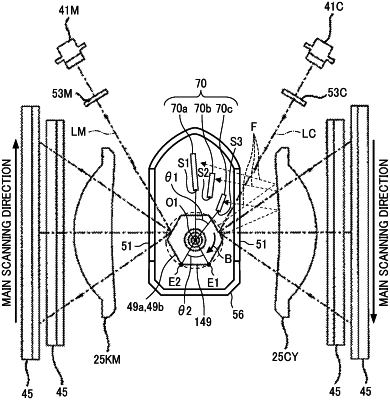| CPC G02B 26/10 (2013.01) [G02B 26/0816 (2013.01)] | 7 Claims |

|
1. An optical scanning device comprising:
a plurality of light sources;
a deflector including a plurality of mirror surfaces and configured to reflect light beams from the plurality of light sources on the plurality of mirror surfaces while rotating to deflect the light beams into different directions from each other;
an optical element facing the deflector and configured to guide each one of the light beams deflected by the deflector to corresponding one of a plurality of bodies to be scanned to form an image on the corresponding one of the plurality of bodies to be scanned; and
a plurality of light blockers disposed adjacent to the deflector and configured to block flare light from the optical element facing the deflector, each one of the light blockers having an end portion located toward the deflector,
wherein, when viewed from a rotation axis direction of the deflector, the plurality of light blockers are spaced apart from each other in a rotation direction of the deflector, and
an inequality θ1<θ2 is satisfied,
wherein, when viewed from the rotation axis direction, θ1 is an angle formed by a line segment connecting the end portion of a light blocker disposed most downstream in the rotation direction among the plurality of light blockers to a rotation axis center of the deflector and a line segment connecting the end portion of a light blocker disposed most upstream in the rotation direction among the plurality of light blockers to the rotation axis center, and
θ2 is an angle formed by a line segment connecting an upstream end portion of one of the plurality of mirror surfaces in the rotation direction to the rotation axis center and a line segment connecting a downstream end portion of the one of the plurality of mirror surfaces in the rotation direction to the rotation axis center.
|